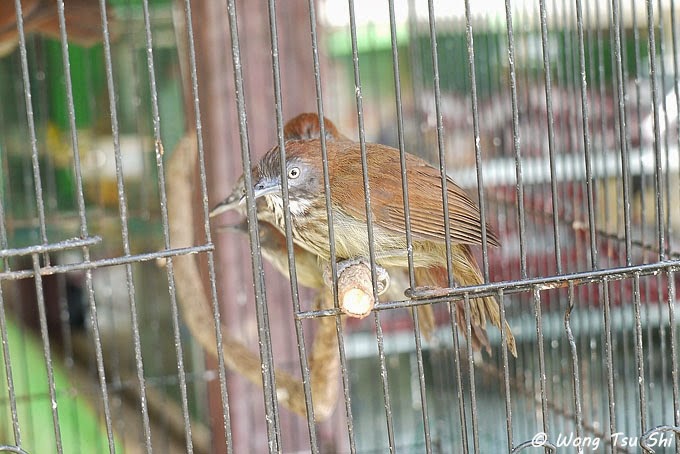On the way to the airport on our way back, we stopped at two places where cage birds were openly on sale, one was housed in a building while the other was made up of a few stalls with birds in cages piled on top of each other on mobile carts.
Here are some images I managed to take of these two places. It is sad to note that I saw a few "lifers" there, being birds that I have yet to photograph in the wild but seen here inside cages.

This is the shop, there is a Long-tailed Shrike Lanius schach in one of the hanging cages in the fore ground.
Bold-striped Tit-babbler Macronous bornensis .
A cage of Yellow-vented Bulbul Pycnonotus goiavier and Sooty-headed Bulbul Pycnonotus aurigaster. The wild population of the latter in pockets in Kalimantan must have originated from cage birds.
There are many caged White-rumped Shama Copsychus malabaricus , that's why it is so hard to see one in the wild there.
Mobile stalls, the building in the background is also in this trade as the cages are visible in this picture.
Mobile stalls from another angle.
Chestnut-cheeked Starlings Sturnus philippensis that will not be returning to their home, sandwiched by cages of various doves and pigeons.Cages and cages on top of each other.
Chestnut-capped Thrush Zoothera interpres, I have yet to photograph one in the wild.
There are a lot of Chestnut-cheeked Starlings.
Yellow-vented Bulbuls.
Large Green-pigeon Treron capellei, I have yet to photograph one in the wild.
This is a Pied Starling Gracupica contra, a bird not in the Bornean Checklist.
Chectnut-backed Scimitar-babbler Pomatorhinus mantanus, which is not an easy bird to see in the wild.

This is definitely a non-Bornean species, I suspect it is from Java but have no resources to check what it is.

Surprisingly, Large-billed Blue Flycatcher Cyornis caerulatus also can be caged.
This is Yellowed Bellied White-eye or Lemon-bellied White-eye Zosterops chloris, mentioned in both Phillipps and Myers as only found in Karitmata, Matasirih and Marabatuan, which are islands off the coast of south and west of Borneo. Here they are, quite a few of them in cages for sale.
I even saw a fire-tufted Barbet Psilopogon pyrolophus, which is not in the Bornean checklist, for sale.
On casual conversation with the traders, we were told that some of the birds were imported from Java, which explained the origin of those non-Bornean birds on sale.
Considering the deep-rooted tradition of trapping and caging birds in this part of the world, I believe this is a negligible and immaterial part of the huge cage bird trade in Kalimantan. I can't help but keep thinking about the number of birds species not in our traditional checklist imported to the island of Borneo which managed to escaped and gone feral in the whole of Kalimantan over these years, bear in mind that Kalimantan occupies the largest part of the island covering 72.57% of the land area.
A major revision to the Bornean Checklist might be required if we have adequate data from that part of Borneo.














